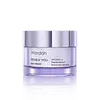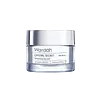What's inside
What's inside
 Key Ingredients
Key Ingredients

 Benefits
Benefits

 Concerns
Concerns

 Ingredients Side-by-side
Ingredients Side-by-side

Bakuchiol
AntimicrobialNiacinamide
SmoothingPalmitoyl Pentapeptide-4
Skin ConditioningWater
Skin ConditioningEthylhexyl Methoxycinnamate
UV AbsorberBiosaccharide Gum-1
HumectantPropylene Glycol
Humectant4-Methylbenzylidene Camphor
UV AbsorberCetyl Alcohol
EmollientGlycerin
HumectantGlyceryl Stearate
EmollientPolyacrylamide
Butyl Methoxydibenzoylmethane
UV AbsorberDimethicone
EmollientPhenoxyethanol
PreservativeCyclopentasiloxane
EmollientStearic Acid
CleansingPEG-100 Stearate
Butylene Glycol
HumectantC13-14 Isoparaffin
EmollientHydrolyzed Wheat Protein/Pvp Crosspolymer
Parfum
MaskingLaureth-7
EmulsifyingDimethicone Crosspolymer
Emulsion StabilisingEthylhexylglycerin
Skin ConditioningAllantoin
Skin ConditioningResveratrol
AntioxidantTocopheryl Acetate
AntioxidantDisodium EDTA
Sodium Hyaluronate
HumectantCarbomer
Emulsion StabilisingDimethicone/Vinyl Dimethicone Crosspolymer
Skin ConditioningPolysorbate 20
EmulsifyingPotassium Sorbate
PreservativeEDTA
Dimethiconol
EmollientPalmitoyl Oligopeptide
CleansingPalmitoyl Tetrapeptide-7
Skin ConditioningBakuchiol, Niacinamide, Palmitoyl Pentapeptide-4, Water, Ethylhexyl Methoxycinnamate, Biosaccharide Gum-1, Propylene Glycol, 4-Methylbenzylidene Camphor, Cetyl Alcohol, Glycerin, Glyceryl Stearate, Polyacrylamide, Butyl Methoxydibenzoylmethane, Dimethicone, Phenoxyethanol, Cyclopentasiloxane, Stearic Acid, PEG-100 Stearate, Butylene Glycol, C13-14 Isoparaffin, Hydrolyzed Wheat Protein/Pvp Crosspolymer, Parfum, Laureth-7, Dimethicone Crosspolymer, Ethylhexylglycerin, Allantoin, Resveratrol, Tocopheryl Acetate, Disodium EDTA, Sodium Hyaluronate, Carbomer, Dimethicone/Vinyl Dimethicone Crosspolymer, Polysorbate 20, Potassium Sorbate, EDTA, Dimethiconol, Palmitoyl Oligopeptide, Palmitoyl Tetrapeptide-7
Water
Skin ConditioningEthylhexyl Methoxycinnamate
UV AbsorberButylene Glycol
HumectantNiacinamide
SmoothingButyl Methoxydibenzoylmethane
UV AbsorberOctocrylene
UV AbsorberButyloctyl Salicylate
Skin ConditioningCyclopentasiloxane
EmollientPentylene Glycol
Skin ConditioningVinyldimethicone
Arachidyl Alcohol
EmollientAluminum Starch Octenylsuccinate
AbsorbentBisabolol
MaskingAlpha-Arbutin
AntioxidantActinidia Polygama Fruit Extract
Skin ConditioningLeontopodium Alpinum Extract
Skin ConditioningAmmonium Acryloyldimethyltaurate/Vp Copolymer
Behenyl Alcohol
EmollientArachidyl Glucoside
EmulsifyingParfum
MaskingSodium Hydroxide
BufferingGlycerin
HumectantCitric Acid
BufferingPotassium Sorbate
PreservativeSodium Benzoate
MaskingChlorphenesin
AntimicrobialPhenoxyethanol
PreservativeWater, Ethylhexyl Methoxycinnamate, Butylene Glycol, Niacinamide, Butyl Methoxydibenzoylmethane, Octocrylene, Butyloctyl Salicylate, Cyclopentasiloxane, Pentylene Glycol, Vinyldimethicone, Arachidyl Alcohol, Aluminum Starch Octenylsuccinate, Bisabolol, Alpha-Arbutin, Actinidia Polygama Fruit Extract, Leontopodium Alpinum Extract, Ammonium Acryloyldimethyltaurate/Vp Copolymer, Behenyl Alcohol, Arachidyl Glucoside, Parfum, Sodium Hydroxide, Glycerin, Citric Acid, Potassium Sorbate, Sodium Benzoate, Chlorphenesin, Phenoxyethanol
Ingredients Explained
These ingredients are found in both products.
Ingredients higher up in an ingredient list are typically present in a larger amount.
Also known as Avobenzone, this ingredient is a chemical sunscreen filter that provides protection in the UV-A range.
Avobenzone is globally approved and is the most commonly used UV-A filter in the world.
Studies have found that avobenzone becomes ineffective when exposed to UV light (it is not photostable; meaning that it breaks down in sunlight). Because of this, formulations that include avobenzone will usually contain stabilizers such as octocrylene.
However, some modern formulations (looking at you, EU!) are able to stabilize avobenzone by coating the molecules.
Avobenzone does not protect against the UV-B range, so it's important to check that the sunscreen you're using contains other UV filters that do!
The highest concentration of avobenzone permitted is 3% in the US, and 5% in the EU.
Learn more about Butyl MethoxydibenzoylmethaneButylene Glycol (or BG) is used within cosmetic products for a few different reasons:
Overall, Butylene Glycol is a safe and well-rounded ingredient that works well with other ingredients.
Though this ingredient works well with most skin types, some people with sensitive skin may experience a reaction such as allergic rashes, closed comedones, or itchiness.
Learn more about Butylene GlycolCyclopentasiloxane, or D5, is a silicone used to improve texture of products and trap moisture.
D5 is considered lightweight and volatile. Volatile means it evaporates quickly after application. Once evaporated, D5 leaves a thin barrier that helps keep skin hydrated.
It is also an emollient. Emollients help soften the skin and prevent water loss. Silicones create a silky texture in products. D5 helps other ingredients become more spreadable.
Studies show D5 is safe to use in skincare products. We recommend speaking with a skincare professional if you have concerns.
Learn more about CyclopentasiloxaneEthylhexyl Methoxycinnamate is an organic compound that provides UVB protection. It often goes by the more common name of octinoxate. It is created from methoxycinnamic acid and 2-ethylhexanol.
Ethylhexyl Methoxycinnamate absorbs UVB rays with wavelengths between 280-320 nm. UV absorbers protect your skin by using chemical reactions to convert UV rays into heat and energy.
UVB (290-320 nm) rays emit more energy than UVA rays. They are capable of damaging DNA, causing sunburns and are thought to be linked to skin cancer.
The state of Hawaii has banned sunscreens containing octinoxate due to its potential impact on coral reefs. More research is needed to bridge gaps in this research. The European Union allows higher levels of octinoxate in sunscreens than the US and Australia.
Ethylhexyl Methoxycinnamate is oil soluble. It is not stable and may lose efficacy when exposed to sunlight.
Learn more about Ethylhexyl MethoxycinnamateGlycerin is already naturally found in your skin. It helps moisturize and protect your skin.
A study from 2016 found glycerin to be more effective as a humectant than AHAs and hyaluronic acid.
As a humectant, it helps the skin stay hydrated by pulling moisture to your skin. The low molecular weight of glycerin allows it to pull moisture into the deeper layers of your skin.
Hydrated skin improves your skin barrier; Your skin barrier helps protect against irritants and bacteria.
Glycerin has also been found to have antimicrobial and antiviral properties. Due to these properties, glycerin is often used in wound and burn treatments.
In cosmetics, glycerin is usually derived from plants such as soybean or palm. However, it can also be sourced from animals, such as tallow or animal fat.
This ingredient is organic, colorless, odorless, and non-toxic.
Glycerin is the name for this ingredient in American English. British English uses Glycerol/Glycerine.
Learn more about GlycerinNiacinamide is a multitasking form of vitamin B3 that strengthens the skin barrier, reduces pores and dark spots, regulates oil, and improves signs of aging.
And the best part? It's gentle and well-tolerated by most skin types, including sensitive and reactive skin.
You might have heard of "niacin flush", or the reddening of skin that causes itchiness. Niacinamide has not been found to cause this.
In very rare cases, some individuals may not be able to tolerate niacinamide at all or experience an allergic reaction to it.
If you are experiencing flaking, irritation, and dryness with this ingredient, be sure to double check all your products as this ingredient can be found in all categories of skincare.
When incorporating niacinamide into your routine, look out for concentration amounts. Typically, 5% niacinamide provides benefits such as fading dark spots. However, if you have sensitive skin, it is better to begin with a smaller concentration.
When you apply niacinamide to your skin, your body converts it into nicotinamide adenine dinucleotide (NAD). NAD is an essential coenzyme that is already found in your cells as "fuel" and powers countless biological processes.
In your skin, NAD helps repair cell damage, produce new healthy cells, support collagen production, strengthen the skin barrier, and fight environmental stressors (like UV and pollution).
Our natural NAD levels start to decline with age, leading to slower skin repair, visible aging, and a weaker skin barrier. By providing your skin niacinamide, you're recharging your skin's NAD levels. This leads to stronger, healthier, and younger looking skin.
Another name for vitamin B3 is nicotinamide. This vitamin is water-soluble and our bodies don't store it. We obtain Vitamin B3 from either food or skincare. Meat, fish, wheat, yeast, and leafy greens contain vitamin B3.
The type of niacinamide used in skincare is synthetically created.
Learn more about NiacinamideParfum is a catch-all term for an ingredient or more that is used to give a scent to products.
Also called "fragrance", this ingredient can be a blend of hundreds of chemicals or plant oils. This means every product with "fragrance" or "parfum" in the ingredients list is a different mixture.
For instance, Habanolide is a proprietary trade name for a specific aroma chemical. When used as a fragrance ingredient in cosmetics, most aroma chemicals fall under the broad labeling category of “FRAGRANCE” or “PARFUM” according to EU and US regulations.
The term 'parfum' or 'fragrance' is not regulated in many countries. In many cases, it is up to the brand to define this term.
For instance, many brands choose to label themselves as "fragrance-free" because they are not using synthetic fragrances. However, their products may still contain ingredients such as essential oils that are considered a fragrance by INCI standards.
One example is Calendula flower extract. Calendula is an essential oil that still imparts a scent or 'fragrance'.
Depending on the blend, the ingredients in the mixture can cause allergies and sensitivities on the skin. Some ingredients that are known EU allergens include linalool and citronellol.
Parfum can also be used to mask or cover an unpleasant scent.
The bottom line is: not all fragrances/parfum/ingredients are created equally. If you are worried about fragrances, we recommend taking a closer look at an ingredient. And of course, we always recommend speaking with a professional.
Learn more about ParfumPhenoxyethanol is a preservative that has germicide, antimicrobial, and aromatic properties. Studies show that phenoxyethanol can prevent microbial growth. By itself, it has a scent that is similar to that of a rose.
It's often used in formulations along with Caprylyl Glycol to preserve the shelf life of products.
Potassium Sorbate is a preservative used to prevent yeast and mold in products. It is commonly found in both cosmetic and food products.
This ingredient comes from potassium salt derived from sorbic acid. Sorbic acid is a natural antibiotic and effective against fungus.
Both potassium sorbate and sorbic acid can be found in baked goods, cheeses, dried meats, dried fruit, ice cream, pickles, wine, yogurt, and more.
You'll often find this ingredient used with other preservatives.
Learn more about Potassium SorbateWater. It's the most common cosmetic ingredient of all. You'll usually see it at the top of ingredient lists, meaning that it makes up the largest part of the product.
So why is it so popular? Water most often acts as a solvent - this means that it helps dissolve other ingredients into the formulation.
You'll also recognize water as that liquid we all need to stay alive. If you see this, drink a glass of water. Stay hydrated!
Learn more about Water